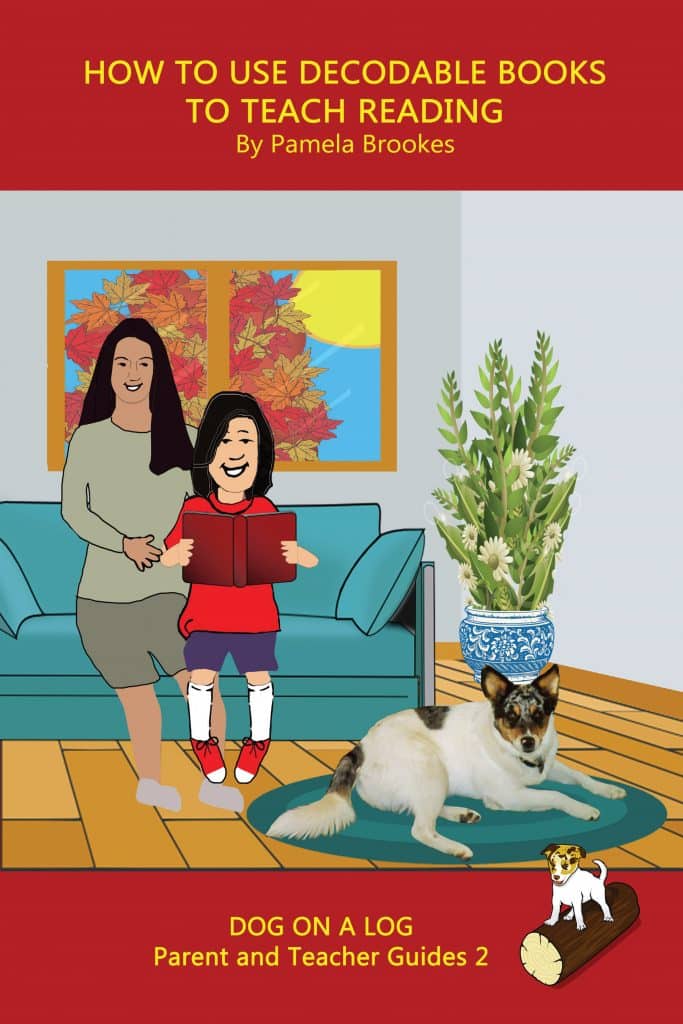
The complete Free How to Use Guide e-booklet is available to read after this introduction or
You can get it FREE as an e-book
at Amazon or
at many of your favorite online booksellers.
Individual merchants have the discretion to charge for it.
Please note: This website contains affiliate links. If I’m an affiliate, it’s because I believe in a product.
As an Amazon Associate I earn from qualifying purchases.
dyslexia book You will be able to download the Second Edition from many online booksellers in the next day or two.
Sixty-five percent of U.S. fourth graders are not proficient readers because their teachers have not been taught how to teach reading using evidence-based methods. Up to 20% of children have dyslexia. Few receive the individualized teaching they need from their schools.
To help parents and teachers who want to teach their children using an evidence-based, effective method, Pamela Brookes, the mother of a child with dyslexia, discusses their daily routine as she teaches her daughter to read using the decodable DOG ON A LOG Books series. As the author of DOG ON A LOG Books, Pamela also shares how to choose where in the series to start. She shares how she teaches each of the phonics rules used in the book series along with the reasons for teaching the syllable types and handwriting. Although this booklet is meant to guide parents and teachers using DOG ON A LOG Books, the information can be adapted and applied to any systematic series of decodable books.
How to Use DOG ON A LOG Books to Teach Reading is edited by Dr. Nancy Mather, a professor in learning disabilities, reading, and writing to make sure it follows the scientific research on teaching to read.
This edition includes information on Steps 1 to 10 of the DOG ON A LOG phonics rules. Additional steps will be added as the books are created.
All DOG ON A LOG Books follow a structured literacy/Orton-Gillingham based phonics sequence.
How to Use Decodable Books to Teach Reading
By Pamela Brookes
I am not a Reading Specialist or certified educator. The content provided herein is for informational purposes and does not take the place of an evaluation and teaching plan provided by a credentialed educator. Every effort has been made to ensure that the content provided here is accurate and helpful for my readers. However, this is not an exhaustive treatment of the subject. No liability is assumed for losses or damages due to the information provided. You should consult a credentialed educator for specific guidance on educating your child, yourself, or others.
DOG ON A LOG Books
Tucson, Arizona
Copyright ©2019 By Pamela Brookes
All Rights Reserved.
For information, contact the publisher at
read@dogonalogbooks.com
Public Domain images from www.clker.com
Free dyslexia e-book Teaching A Struggling Reader: One Mom’s Erience With Dyslexia
Table of Contents
This is an Instruction Manual
Foreword
Let’s Begin
How do Decodable Books Work?
Where in the Series do We Start?
DOG ON A LOG Phonics Progression
DOG ON A LOG Quick Assessment
Figuring It Out
We Know What Step of DOG ON A LOG Books, Now What?
We’ve Chosen Books. What’s Next?
Handwriting
Before You Start a New Step of Phonics/Books
Regarding Magnetic Letters:
A Note about Pictures:
And Our Ideal Daily Routine is…
1 Read every day.
2 Practice the words or rules she needs to practice.
3 Fluency
4 Teaching Comprehension
5 Write every day.
6 Reading for enjoyment
Individual Phonics Rules
Step 1
Syllables
Syllable Type: Closed
Step 2
Step 3
Step 4
Step 5
Syllable Type: VCe
Step 6
Step 7
Step 8
Step 9 (In Production)
Syllable Type: Double Vowel
Step 10 (Upcoming)
Syllable Type: Open
FOREWORD moved to the back. I guess this is now the BACKWORD
Excerpts from Teaching a Struggling Reader: One Mom’s Experience with Dyslexia
Irregular or Sight Words
Tapping (Sounding Out)
Letter Reversals
“b” and “d” Make Your Bed
“p” and “g” See a Pig
“q” Is a Chicken Letter
Motivators
Rewards as a Motivator
Reading Together as a Motivator
Play as a Motivator
Why Decodable Books?
This is an Instruction Manual
This book is for parents and teachers. It’s for parents who will teach their children to read. Perhaps they homeschool, perhaps their child’s school is not providing the instruction their child needs, perhaps they are a parent who is wanting to supplement what their kids do at school. It is also written for teachers who were not taught evidence-based methods of teaching reading and they want an introduction to what they were not taught in college.
This book tells you step by step how I teach my daughter to read using the decodable books I write for her. Those books have bikes that turn into elk, real-life bikes for blind children to ride, and caves filled with all kinds of wonders.
You will not find any of those fun moments in this book. This is more like the instruction manual that tells you how to change the filter in your coffee pot or how to build a bunkbed out of three hundred pieces. The material here is dense. It condenses what I have learned in three years to a few score of pages. So, go slow. Read the section you need now. Go Step by Step as you would if you were building the previously mentioned bunkbed. If you were building a bed you would read “Step 1: Set Slat A on top of Piece 1.” If you tried to worry about Step 327 before you finished Step 1, you might get overwhelmed. Granted, you need to have a rough idea of what you’ll need to do and what materials you’ll need before starting, but you wouldn’t try to memorize all the bunkbed steps just as it may take you awhile to get up to speed with the teaching reading process.
I am guessing your goal is to teach your child to read a sentence like, “The tough coughs as he ploughs the dough, though he should work through it.” It will take your child time to learn to read that sentence. I have the same goal for my daughter. This book will show you how I am using explicit systematic phonics to teach my daughter to overcome the challenges of both the English language and her dyslexia so she, too, will be able to read that sentence.
This book was originally called How to Use DOG ON A LOG Books to Teach Reading. I was never satisfied with that title. Although this book is clearly written about DOG ON A LOG Books, the information can be used with any systematic series of decodable text. I decided to change the name to How to Use Decodable Books to Teach Reading so that people who want to use other decodable texts will know the information contained is useful for them. The daily routine I use with my daughter will apply to any set of decodable texts as will the phonics rules. The order of the phonics rules and the exact wording of the phonics rules will likely vary between different sets of books, but the rules and the type of explicit instruction needed will ultimately be the same.
Foreword
I’m hearing from families who can’t afford tutors (as well as librarians and teachers) that they want to know how to use DOG ON A LOG Books or other decodable texts to teach their child to read. I will do my best to answer that. However, please remember I am a mom, not a trained reading teacher or dyslexia specialist. I have learned a lot about teaching reading to anyone, including individuals with dyslexia, from my daughter’s dyslexia tutors and other dyslexia experts. I can tell you what works for us and what works for a lot of other learners. I cannot answer every question for every learner. If what I tell you isn’t working for your child (or adult learner) you will need to find a dyslexia specialist that can help you. Make sure they are trained in using a Structured Literacy or Orton-Gillingham approach.
The first draft of the foreword had important information, but there were too many words. They made my eyes spin. To “cut to the chase,” I have moved most of the foreword material to the back of the book. It’s there if you want to read it.
If you want more information on struggling readers, whether or not they have dyslexia, I answered the questions I wish I’d known to ask during the early stages of our dyslexia journey in Teaching a Struggling Reader: One Mom’s Experience with Dyslexia. You can get it as a free e-book, read it at www.dogonalogbooks.com/free or buy it as a paperback.
This is an excellent source for information on teaching reading. It is rather academic and dense, but the information is excellent: Put Reading First: The Research Building Blocks for Teaching Children to Read Kindergarten Through Grade 3.
Let’s Begin
First, decodable books aren’t just for individuals with dyslexia. Scientifically-based research has shown that “systematic and explicit phonics instruction is more effective than non-systematic or no phonics instruction.”
DOG ON A LOG Books are a systematic, sequential series of books. Adding explicit instructions in the phonics rules used will help most new readers learn how to read. Readers with dyslexia will likely need more instruction and repetition, but the same books will be useful.
Second, as the mom to a child with dyslexia, there is hope. Teaching a child with dyslexia to read takes a LOT of patience and repetition, but you can get there. (And let me mention, the amount of repetition needed is unbelievable.)
Third, there are a few topics I have written about in Teaching a Struggling Reader as well as in The Squiggle Code books that can be useful in teaching a child to read. You will probably want to read about them before starting to use the books. The topics include learning sight words, “tapping” (tapping your fingers to help sound out words,) addressing letter reversals, and various motivators for young kids who are feeling challenged. I am including those excerpts at the end of this book.
Fourth, the information in this booklet will be useful even if you do not use DOG ON A LOG decodable books. You will likely have to adapt the phonics progression, but the phonics rules and the activities in my family’s daily routine can be applied to other series.
How do Decodable Books Work?
Decodable books. are written with very controlled language so that anyone who has been taught the phonics rules and sight words included can read them. A systematic series means the series of books are written to build upon each other. Each Step of books introduces a few phonics rules. The next Step introduces a few more, and so on. That’s what kids, especially kids with dyslexia, need when learning to read. They need a few rules that they get good at, then a few more rules that they get good at, then a few more rules they get good at. They need to be pretty good at each set of rules before they move on to the next set.
This is why DOG ON A LOG Books have so many books at each Step. It is also why I am starting to provide FREE downloadable flashcards, games, and other activities on my printables pages. Kids learning to read need various ways to learn and practice the phonics rules. With some kids, you can simply tell them, “This is the rule” and they get it. Other kids will need to play games or do flashcards or worksheets or crafts or whatever works for that child. They generally need to master the rule before they are ready to move on.
The reason I say “generally” is my daughter’s current tutor sees there are times that a child isn’t mastering a specific rule, but she’s confident they will learn the next rule. In that case she introduces the new rule while still reinforcing the rule the child didn’t totally master. She talks about kids that might spend two years on the first couple levels of their program without advancing. For some kids, that is the best choice. For other kids, the sense of failure at not progressing is a greater impediment than not mastering a level. This is why teaching children with dyslexia can be so hard. Each child is different and different choices work for different children.
Where in the Series do We Start?
This will vary depending on the text or books you are using. If you are using a different series of books, you will need to look at their Phonics Progression which may also be called the Scope and Sequence. Where in a series you precisely start with will depend on what your child has been taught and what they have mastered. If they’re not reading at all, you will want to start with phonological and phonemic awareness skills.
I have written a Parent-friendly series of books called DOG ON A LOG Pup Books. The first book in that series is called Before the Squiggle Code. It is the book you will want to start with if your child is not reading at all.
Even if your child is reading some, but they are struggling, you may want to consider starting with a book like Before the Squiggle Code. I have been teaching reading to some kids in a homeschool co-op phonics class. Although each had started learning to read before I began working with them, I started the class at the very beginning by using Before the Squiggle Code. All the kids gained a lot from that book and all the associated games we played. One child learned how to rhyme, another was started hearing the syllables in words. All of them got a lot out of learning how to “tap” the sounds in words. “Tapping” is such an important skill that I talk about it in all three of my other non-fiction books and I will include that information in the excerpts at the end of this book.
My co-op phonics class was offered in the spring. Over the following summer one of the kids had a huge reading spurt. His mom credits what he learned from Before the Squiggle Code for helping him gain so many reading skills in the three months following that class. If I hadn’t done that “remedial” work with him since he was already reading some, he may not have developed the very basic skills he needed to help him get good at reading. When I used the DOG ON A LOG Quick Assessment Tool with him when he prepared to start the fall semester, I discovered he had gone from not reading to reading every word on the tool. That’s pretty unusual, but I was so pleased. He ended up taking a different class as he clearly did not need additional phonics instruction from me.
If you are uncertain whether your child could benefit from the very first skills in Before the Squiggle Code, you may wish to make sure they have mastered them. You can do this by using a phonemic awareness screening tool. I looked at several, but most are not written for parents. They can be easy to use, but they don’t list by what age a child should be mastering a skill. As a parent, I found this screener the easiest to understand. It costs just a few dollars, to download: Phonemic Awareness and Dyslexia Screening Tool. It can be used after the first 9 weeks of kindergarten.
This particular screening tool also includes asking children to say the names of letters. If they haven’t been taught the letter names, (which is what they will learn in The Squiggle Code,) they would not, of course, get that portion of the assessment correct.
I have been told that, since every child develops at their own pace, it may be perfectly normal for kids to master any of these skills later than other children. However, if your child is still not mastering skills 6 to 12 months after other kids have mastered them, you should probably contact a dyslexia or learning disabilities specialist.
Angie Neal, M.S., CCC-SLP, the developer of the tool messaged me, “These are average age ranges. That means it wouldn’t be considered ‘disordered’ unless they are significantly behind. I would consider 6 months behind as delayed and a year or more behind as disordered. I would not consider one skill as a single predictor, but I would be sure to support development of that skill through reading and word play frequently.”
If your child has not mastered all the skills in Angie Neal’s screener, I recommend you start with the first DOG ON A LOG Pup Book, Before the Squiggle Code.
If your child has the skills in that screener, the next questions are if they know the letters and their sounds and if they can blend them together to make words. If they can, then you can probably skip the second Pup Book, The Squiggle Code. The letter sounds they need to know are described later in the section on Individual Phonics Rules.
If your child doesn’t know the letter sounds and can’t blend them or sound them out in words, then The Squiggle Code will help you teach them those skills.
To help teach the skills in both Pup Books, I have all kinds of syllable games, letter flashcards, keyword tables, and other printable pre-reading activities that you can download for free.
If your child knows the short vowel and primary consonant sounds and how to blend them into words, then look at the following phonics progression. (I am including the skills from the Pup Books as well.) There is a quick assessment tool after the progression list. If the phonics list is too confusing, just skip it and go straight to the DOG ON A LOG Quick Assessment.
DOG ON A LOG Books, are written so that most of the books are independent stories so your child will not miss an important plot point if they don’t start with Book 1. Beginning in Step 9, there are mini-series within the series, such as a five-book mystery that spans five Steps of phonics. Those books will be clearly labeled as part of a mini-series.
DOG ON A LOG Phonics Progression
DOG ON A LOG Pup Books
Book 1
Phonological/Phonemic Awareness:
Words
Rhyming
Syllables, identification, blending, segmenting
Identifying individual letter sounds
Books 2-3
Phonemic Awareness/Phonics
Consonants, primary sounds
Short vowels
Blending
Introduction to sight words
DOG ON A LOG Let’s GO! and Chapter Books
Step 1
Consonants, primary sounds
Short vowels
Digraphs: ch, sh, th, wh, ck
2 and 3 sound words
Possessive ‘s
Step 2
Bonus letters (f, l, s, z after short vowel)
“all”
–s suffix
Step 3
Letter Buddies: ang, ing, ong, ung, ank, ink, onk, unk
Step 4
Consonant blends to make 4 sound words
3 and 4 sound words ending in –lk, -sk
Step 5
Digraph blend –nch to make 3 and 4 sound words
Silent e, including “-ke”
Step 6
Exception words containing: ild, old, olt, ind, ost
Step 7
5 sounds in a closed syllable word plus suffix -s (crunch, slumps)
3 letter blends and up to 6 sounds in a closed syllable word (script, spring)
Step 8
Two syllable words with 2 closed syllables, not blends (sunset, chicken, unlock)
Step 9 (In Production)
Two syllable words with all previously introduced sounds including blends, exception words, and silent “e” (blacksmith, kindness, inside)
Vowel digraphs: ai, ay, ea, ee, ie, oa, oe (rain, play, beach, tree, pie, goat, toe)
Step 10 (Upcoming)
Open syllables including y as the long vowel sound “i” (be, so, dry)
2 syllable words containing:
Open syllables (beside, recall, myself)
Previously learned sight words (outside, somewhere)
vowel teams ai, ea, ee, ie, oa, oe (raindrop, sixteen)
DOG ON A LOG Quick Assessment
This assessment is specifically for DOG ON A LOG Books. If you are using a different series, you will need to use their resources to determine where in their series to start.
To help you figure out what Step of DOG ON A LOG Books might be the best starting point for your child, have them read the following lists of words. This list of words is also available as an assessment tool. Start with Step 1. If they get all of the words correct, go on to Step 2. Continue until they reach a Step where they miss one or more words. That is the Step you should probably start with. If they struggle with this Step, you can always move back a Step.
Or you may want to start with a Step where your child is able to read the complete set of words. Let them practice and build confidence.
Regarding skipping steps:
The DOG ON A LOG Books are systematic and sequential. That means the steps build upon each other. Skipping a Step that your child has not mastered could be problematic as they will struggle when they encounter those words in future steps.
An example of when it might work to skip a Step would be if they had already mastered one step, but not a prior one. For example, let’s say they have mastered Steps 1 and 2 as well as consonant blends (Step 4,) but not letter buddies with ng or nk (Step 3.) In that example, you would have them read and master Step 3 then consider skipping Step 4.
The printable assessment tool includes a word list in columns as well as rows.
Step 1
fin, mash, sock, sub, cat, that, Dan’s
Step 2
less, bats, tell, mall, chips, whiff, falls
Step 3
bangs, dank, honk, pings, chunk, sink, gong, rungs
Step 4
silk, fluff, smash, krill, drop, slim, whisk
Step 5
hunch, crate, rake, tote, inch, mote, lime
Step 6
child, molts, fold, hind, jolt, post, colds
Step 7
strive, scrape, splint, twists, crunch, prints, blend
Step 8
finish, denim, within, bathtub, laptop, medic, habit
Step 9 (in production)
hundred, goldfinch, free, wheat, inhale, play, Joe
Step 10 (upcoming)
be, remake, spry, repeat, email, sometime, pinwheel
Figuring It Out
Which of those rules and words does your child know? If they don’t know the digraphs in Step 1, then start there. If they know the rules in Steps 1-4 but not Step 5, then start at Step 5 or maybe Step 4.
Something that could be a little challenging is that each phonics program teaches the phonics rules in a different order. When I was first writing DOG ON A LOG Books I was really worried about that. I wanted to write books that could be used by anyone learning to read. The reality is that unless a teacher is using the specific DOG ON A LOG phonics progression, you will have to choose the Step of books that is most appropriate for your child and you will have to make sure they know all the phonics rules and sight words in that book before they start reading it. It could be that the DOG ON A LOG phonics progression is too different from what your child has been taught and you may need to find a different set of books for the moment.
The DOG ON A LOG phonics progression is developed by my daughter’s teacher for MY daughter. We then adapt the progression to make sure it makes sense for as many other learners as we can. I wish that I could meet the needs of every single person learning to read, but that really isn’t possible. Every learner has individual needs. Sometimes that means DOG ON A LOG Books are exactly what they need. Other times it means they will have to take a break from my books and come back at a different time. The important thing is that the teacher (whether that’s a trained teacher or a parent) must figure out what the best choice is for that specific learner.
We Know What Step of DOG ON A LOG Books, Now What?
If your child is in the very beginning stages included in Before the Squiggle Code and The Squiggle Code, those books are detailed and will give you guidance. I will not go into detail about the topics included in those books.
If your child is ready for Step 1 or later books, let’s talk.
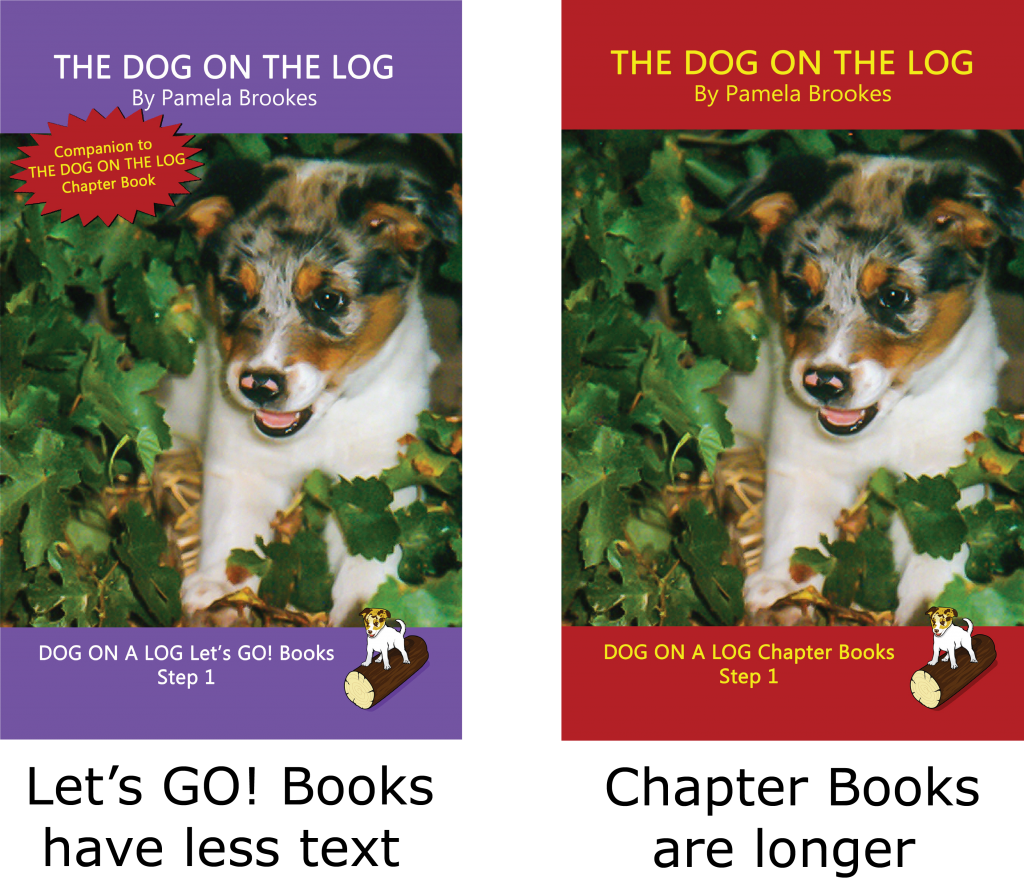
If your child is in Steps 1-5, you can choose between chapter books and Let’s GO! Books. For some kids, the RED chapter books are really intimidating because they have so many words. The very first chapter book has 260 words! To help new readers get used to reading so much, I have the PURPLE Let’s GO! Books. They tell the same story and have the same pictures as the chapter books, but don’t have so many words. The very first Let’s GO! Book only has 50 words. If your child resists reading a red chapter book, you may find it helpful to read the purple Let’s GO! Book. Then you can say, “You did so well with that. You know the story and you know how to read those words. Let’s try the chapter book. We’ll go slow. You don’t need to read the whole book in one sitting.”
The earliest DOG ON A LOG Books are simple stories and the sentences can seem a bit awkward because the vocabulary is so limited. Most kids (like one of the 10-year-old boys I am teaching,) are so thrilled to be reading that they don’t care about the simplicity of the stories, all they care about is they are able to read an entire 50- or 260-word book.
I do want to let you know that some kids will complain that Step 1 books are “baby books.” My daughter’s tutor says that’s common for slightly older kids to say about all really early books like that. Sometimes it is because the stories really are simple. Other times it might be a bit of bravado. They can tell the books are simple stories and may be intimidated that they will struggle with them and they don’t want to be embarrassed. Ultimately, once struggling readers read them, they tend to stop saying they are baby books.
Should your child make that statement, let them know that the Step 2 books aren’t quite so simplistic and that each Step after that the stories get more complicated. (And in Step 9, which isn’t published yet, I am creating a five-book mystery!)
If you think that your child may resist reading the Step 1 books because the books seem so “young,” you can try starting with Step 2. I will caution you about that, though. There is another series of decodable books that are much more advanced than the earliest DOG ON A LOG Books. They’re wonderful books and I was excited to introduce my daughter to them. They were beyond her abilities but I figured I’d help her with the words she couldn’t sound out. Sigh. That backfired miserably. She got to words she couldn’t read and refused to read any more. She now has the ability to read those books on her own but won’t. I am so frustrated because she needs books beyond just mine and the only other decodable books that are affordable, she won’t read.
We’ve Chosen Books. What’s Next?
First, remember your child, especially if they have dyslexia, is likely to forget skills they already mastered. You may find yourself needing to repeat rules, words, and skills that you thought they already learned. Part of every day’s work may need to include covering old material just to assess if you need to repeat old material.
Second, if your child fights you, that may mean it is really hard to learn to read and write. It could mean it is boring. I know I get bored by all the repetition we have to do. That was especially true in the early days. Perhaps using games will help. When I was creating the printable materials for the Pup Books, I started with worksheets. I got halfway through my first (and only) worksheet and said, “Nope. That’s boring. How else can I do this?” That’s when my first boardgame was born. Your child may be the same. Then again, maybe they don’t like my games. If not, check out www.pinterest.com, www.teacherspayteachers.com to see if they have activities your child may enjoy. If your child DOES like worksheets, then there are lots of them available online. I am not against worksheets. My daughter has done many and they were very helpful. I will likely create some in the future. I just know that boardgames are usually more fun than most worksheets.
Additionally, if your child is resisting, it may help if you have a motivator. I am including an excerpt about motivators with the excerpts at the end of the book.
Handwriting
When teaching, it is usually effective to include as many senses as possible. This is one of the reasons that it is important to teach handwriting. Handwriting lets your child experience letters and words with their hands. It also requires them to produce words and sentences with their newly learned phonics skills. Besides, someday they will likely need to write a grocery list or leave a note for someone. Even though we live in a digital age, legible handwriting is still important in general life.
If you used The Squiggle Code Books, then your child has been instructed on writing using D’Nealian font. However, if they have not, then they should learn handwriting at this time. D’Nealian font is not mandatory, it is simply the font my daughter was taught and it is taught in many schools. It does have the advantage of allowing for easier transition to cursive writing. However, some kids have trouble with the little tails. If you prefer a different font, then that is the one you should use. If your child is having trouble with the D’Nealian tails, then tell them to just make straight lines. I have D’Nealian handwriting sheets for The Squiggle Code available. You can create your own handwriting sheets at https://handwritingworksheets.com/.
My daughter knew most of the letter sounds when we started with her first teacher. She was taught to print in groups of similarly shaped lower-case letters. Teaching lower-case letters first makes sense since most of the letters used in books and other places are lower case. They are the letters kids need to become most familiar with. The exact order the letters are taught if kids already know the letter sounds isn’t too important. It is helpful to organize them in similar shapes. The handwriting letter groups my daughter was taught were:
Group 1: c, o, a, d, g.
Group 2: r, n, m, h, f
Group 3: j, i, l, t, b
Group 4: e, p, q, u, w, k
Group 5: v, x, y, s, z
She was taught the following way to make the letters “b” and “d.” Since many children have trouble differentiating them, writing them this way means that you start at a different place on the line so it is harder to confuse them when you are writing.

For capital letters you can use these groupings:
Group 1: L, F, E, H, T, I, U
Group 2: C, O, Q, G, S, J
Group 3: D, P, B
Group 4: R, K, A, V, M, N, X, Y, Z
My daughter’s teacher was an excellent handwriting teacher. She was very specific that Janelle get the letters perfect. And when I say, “perfect” I mean she had to have each tail exactly the right size and the height and width of each letter exactly right. The width of the letters had to be uniform and the space between letters and words was supposed to perfect. To help her with the correct spacing between words, she showed her how to set a small paperclip between the word she’d written and the word she was about to begin.
In private she told me her standards were so high because all kids naturally stop being so attentive to their handwriting and, as Janelle grew older, her handwriting would be based on how well she started out. She wanted to make sure Janelle had clear, legible handwriting. I am really glad she was so specific in what the letters should look like. In my co-op class I am teaching the letters and being as strict about the letters as she was. It’s amazing how quickly their handwriting has improved.
If your child does not know how to write all the letters, you can use magnetic letters for them to “write” words until they master the letters. Even when they get good at handwriting, you may find magnetic letters are useful time-savers as they give learners a chance to create words without the extra work of handwriting.
Before You Start a New Step of Phonics/Books
Decodable books are books that a learner can sound out because they know the phonics rules and the sight words. Using decodable books limits the frustration a new reader will feel compared to a more standard book that is full of words they cannot figure out. This means that you will have to teach and practice the rules and sight words in each new step of books before you use it.
I will explain the specific rules later in this booklet. However, the process of teaching each rule is more or less the same.
- Explain the rule to the student.
- Many of the phonics rules have keywords that help the reader remember the sound a letter or group of letters makes (I call groups of letters “letter buddies.”) Examples would be dog for “d” and kind for “ind.” Which keywords you use isn’t critical. DOG ON A LOG keywords are the ones my daughter was taught by her teachers or myself. The kids in my phonics class know different keywords that they learned at home. Those are the keywords I use with them.
For words with keywords, one way of practicing those words is with flashcards. “What is the name of this letter? (Or letter buddies if more than one letter.) What is the keyword? What sound does it make?” You can download keyword tables. You can also download various alphabet cards with and without keywords as well. In time I plan to add additional flashcards for letter buddies.
- Show your child a word that follows the rule you are teaching. For example, in Step 3 if you are teaching “ank” you would create the word “bank.” You can create it with magnetic letters or write it on an erasable whiteboard, chalk board, or paper. Have them tap and sound out the word. Tapping is using your fingers as you sound out words. It is such a useful tool that you can read about it at the end of the book. If your child is not able to do that, demonstrate and/or do it with them. If your child cannot recall the sound of a letter or group of letters, have them refer to the appropriate keyword table or flashcard.
- Make new words by changing a letter or two while keeping the letters that are related to the new rule. If you had shown them “bank” you would change the “b” to an “s” to make “sank.” Then you would change the “s” to “th” to make “thank.” Sometimes it is useful to create silly words like “fank” or “mank.” Other kids get overwhelmed by expending the energy for made-up words so that doesn’t work for them.
- Do this for all the new rules in this step of phonics/books you are about to start reading.
- If you feel your child is ready to read books with the new phonics, then teach them the new sight words in the book they will be reading and have them start reading. There is information on teaching sight words at the end of the book.
If you do not feel they are ready to read a book, then keep practicing the individual words then start having them read sentences with those words. I do not yet have sentences for all Steps of books available to download. For those that are available, you can have your child read those sentences. Otherwise you can create your own sentences or pick out a few in the appropriate DOG ON A LOG Book.
- You can practice reading by playing games. Most DOG ON A LOG games can be played using flashcards from any step of phonics/books. Currently, there are sight word and decodable word flashcards for all published steps of DOG ON A LOG books.
You can play boardgames or card games to practice words with the new phonics rules as well as new sight words. If your child prefers other ways of practicing the new phonics/words, there are activities available at www.teacherspayteachers.com as well as from other sources.
- Once you feel your child is ready to read a book, go for it. Keep the keyword tables/flashcards nearby in case they need them. On rare occasions, Janelle (who has finished Step 9 as I write this) forgets words from earlier Steps such as Step 3. Since it’s been so long since we did that step, she doesn’t always remember the keywords as she doesn’t need them anymore. Sometimes I’ll tell her to go get her notebook of keyword tables so she can look it up. Because it is usually a rare occasion, I tend to just tell her the keyword.
Teaching a child with dyslexia the letter sounds and new phonics rules can take a lot of repetition. If you read Teaching a Struggling Reader, you know just how many times I repeated that there is a lot of repetition involved. It can be frustrating for both you and your child to have to do so much repetition. Be creative in how you do this and, if possible, try to make it fun. Definitely get as many senses involved as possible. There were times I just wanted to cry over how much repetition is involved. The desire to cry doesn’t really happen anymore as I’ve seen how much progress Janelle has made. I know repetition is just part of the process. Additionally, as she’s gotten older, her learning has matured and she’s figuring things out more. Overall, it is easier than it used to be, but there is still so much to learn.
Regarding Magnetic Letters:
You can buy sets of magnetic letters and letter boards. (Here are links to two different magnetic letter boards. Although I find the Wilson one sturdier, if you are using the All About Reading program, it may be more cost effective to use theirs if you get their kit.) I also plan on creating printable letters that can be attached to magnets. I’ve got more chapter books to write before I make them. You can check my printables pages to see if I’ve conquered the magnetic letters yet. You can also use regular old magnetic letters and a cookie sheet if you already own them.
As I stated in the section on handwriting, the advantage of magnetic letters is that it can be easier for new learners to use magnets than to write the letters. That said, my daughter’s current teacher said a lot of kids don’t like magnetic letters. For whatever reason, those kids prefer writing them. Use whatever your child prefers. They still need to do handwriting, but for learning new rules and practicing, they can use magnets if they prefer.
A Note about Pictures:
The pictures in DOG ON A LOG Books are included to break up the reading. Even a four-word sentence can be a lot for a new reader, especially if the child is struggling to learn. However, do not ask your child to guess what the word is based on the picture. That does not teach kids how to sound out and read words, it teaches them to guess. If your child wants to get clues from the pictures, I recommend covering the picture with a sheet of paper. When the child successfully decodes (sounds out) the sentence, then you can pull away the paper and get the reward of seeing the picture. I know a lot of teachers have been taught to encourage kids to guess words from looking at the pictures. Sadly, that only teaches guessing and not reading.
And Our Ideal Daily Routine is…
1. Read every day.
Before DOG ON A LOG Books, Janelle read simple books that are equivalent to purple Let’s GO! Books. They had about 8 sentences a book so she wasn’t overwhelmed by the number of words. However, she quickly memorized those short books. She could “read” them without opening the books. That meant she got just a handful of readings out of them and then they were pretty worthless to us. Additionally, those books didn’t progress in phonics instruction. She read the equivalent of my Step 1, then there were no more books to advance to. The advantage of those books was the same as Let’s GO! books, she felt proud that she had read an entire book and she got to practice the skills she was learning.
Once I started writing the chapter books, our reading sessions were five pages at a time. With five books to read at each Step of phonics, she had enough opportunity to practice her reading without us having to worry she’d memorized the books. (We sometimes go back to earlier books even now to practice older skills. Although she knows the stories, she hasn’t memorized the sentences like she did in the really short books.)
In time, as reading got easier, I advanced her to read seven pages each day. When we got to Step 6, I made the book font smaller (the cost of the books was much higher with bigger font as that made them have more pages. To reduce the page count and save families money, I made the text slightly smaller.) Janelle wasn’t aware the font was smaller and that she was actually reading more words. I’ve left our daily reading at seven pages as she’s comfortable with that amount. The number of pages you read each day will depend on your child’s needs and abilities.
When my daughter reads, I monitor every single word. If she reads “talk” when the written word is “talks,” I correct her. If she reads, “a” and the word is “the,” I correct her. She hates that but I tell her I’m just doing what her teacher said I should do. (You can tell your child that it says in this book that is what you have to do.)
If my daughter gets to a decodable word she doesn’t know, I tell her to tap it. Sometimes she thinks she’s too old, in her opinion, to be tapping, I tell her to tap it in her head. That’s not as effective as tapping with her fingers, but it helps. Other times I tell her she doesn’t earn a privilege if she doesn’t tap. If there is a keyword for a sound, I ask her what the keyword is and tell her to get her keyword notebook if necessary. For other phonics rules, I ask her what the rule is. For sight words, I tend to tell her the word. If she just randomly misses a sight word, I don’t get worried. If it becomes a pattern, it’s time to practice the sight word again with tracing strips, writing, and/or flashcards.
Kindness is always forefront in my mind when my daughter is doing her schoolwork. There are days when she can read brand new material with great fluency. There are other days she stumbles over words like “it” and “and” plus half the words in-between. If she’s really, really struggling, I may just tell her some of the words she’s finding the hardest. If she is so overwhelmed that she’s not going to be able to learn that day, I cut the session short. Fortunately, as she gets better at reading, those struggling days are happening less, but they still happen.
2. Practice the words or rules she needs to practice.
This can be decodable words or sight words from the current step of books we’re reading or it can be words from prior steps that she is still struggling with. It can also be time spent working with letter buddies or covering other phonics rules.
This can be done by using magnetic letters, reading flashcards, playing games, or doing other activities. Janelle hates flashcards, but if we play one of my boardgames, she will happily read each flashcard she draws. Although, if the flashcards are words she hasn’t mastered, she may resist the boardgame but will play a card game. Right now, we are playing “Get Tup” (essentially Go Fish) with only one set of cards instead of Go Fish’s two matching sets. We ask for words with the same long vowel sounds instead of the same word. Then if we have a match, we read the words. We are doing this with the long vowel sounds of Step 5 and Step 9. This game really helps her firm up those long vowel sounds. The rules for this game are available to download. They are listed with other card games as “Card Games for all Steps of Phonics” on my this page.
3. Fluency
Fluency is when you are able to read both accurately and quickly. You can read smoothly with expression. Most learners with dyslexia do not read fluently and need extra practice to master this skill. My daughter’s teacher has done repeated reading exercises with her to build fluency. She has her read the same text for one-minute multiple times. Each time she reads just a little bit more. Here is a video demonstrating this procedure. This child’s reading is obviously quite advanced.
We have done repeated reading at home. We set the timer for one minute and she reads. If she is stumbling hard on a word, I just tell it to her. I keep track of how many words she gets wrong or needs help with. At the end of the minute, we mark in the book the last word she read. Each following day we repeat. Generally, she reads faster and more accurately each day.
Echo Reading is where I read a section of text then my daughter reads it back to me. We then read it together. This way she learns the cadence of reading out loud. The Let’s GO! books are good for this as they only have a few sentences on a page so we don’t tend to lose our place as we read the same lines. (We happen to have a few proof copies just lying around.) I don’t recommend buying them for just this purpose, but if you have them or other simple decodable books, you may want to use them when you do echo reading.
You can read about other methods at Building Reading Fluency in Dyslexic Readers or A Focus on Fluency.
4.Teaching Comprehension
Comprehension is the understanding of what you read. Fortunately, my daughter has average to above average comprehension so her teachers have not had to work on that. She will frequently ask me appropriate questions about the story she is reading, even if she is having trouble figuring out the words. She is always quite gleeful when she finds an error for me to fix. Her gleefulness is why I tell her she is my best editor.
Many learners with dyslexia have trouble comprehending what they read because they put so much attention on sounding out the words that they have little attention left to think about what they are reading. If you read the text to them, they can tell you what it means, but figuring out the words is so hard for them that at times that they can’t comprehend what they are reading.
DOG ON A LOG Books are meant to help developing readers learn to decode and practice their reading skills. If they are having troubles understanding what they read and learning to decode doesn’t seem to be improving their comprehension, they need help and materials that I cannot supply. I would encourage you to contact a learning disabilities or dyslexia specialist.
When you talk with a specialist, you will find that many strategies are available to help your child improve comprehension. Examples of comprehension activities include:
- Talking with your child about the sentence, paragraph, page, or book they just read. The less they understand, the more frequently you should stop to discuss what they read.
- Asking your child questions about what they just read.
- Have your child create questions about what they just read.
- Have your child summarize what they just read.
You can learn more about fluency and comprehension at Put Reading First: The Research Building Blocks for Teaching Children to Read Kindergarten Through Grade 3.
5. Write every day
Both Janelle and I dislike her having to write. Janelle hates it because it is so hard. She has to actually generate the words. I don’t like it because she dislikes it so much.
Our goal is to write four sentences and six sight words each day. After each sentence she should edit it. She prefers to do all the editing after writing all the sentences. However, if she makes a mistake in sentence 1, she is likely to keep making it in each additional sentence. If she edits the sentence and corrects her mistake, she tends to get that rule correct in the following sentences.
The sentences she writes are based on the phonics she needs to be practicing. It is easiest on me if I use sentences out of the DOG ON A LOG book she’s currently reading. Sometimes she resists those if she thinks they are too long. If that’s the case, I may come up with a new sentence. Other times I tell her what words I want her to use and she comes up with her own sentence. The advantage to that one is she is learning to create sentences. The downside is more than once I’ve had to say, “’My name is Jan’ is not long enough and it doesn’t use the words I told you to use.” Recently, she has started looking through the book she is reading and choosing a sentence to write. She reads it out loud, closes the book, then writes that sentence.
There are different techniques for teaching editing.
Janelle’s first teacher taught her to:
- Touch each word as I read the sentence to her after she had finished writing it. This makes sure she wrote down all the words.
- Check for correct capitalization.
- Check for correct punctuation.
- Circle all sight words and verify they are all spelled correctly.
- Find every “b” and “d.” Make sure the correct letter was used.
- Underline the digraphs.
- Draw a line under each consonant in a consonant blend.
- Circle all the letter buddies.
- Read each word and “tap” it to make sure it is spelled correctly.
My daughter’s tutor has her mark words for the type of syllable they are. I don’t do this at home. If you are your child’s primary reading teacher, you may want to do this a few times a week. I will discuss this when I talk about the specific phonics rules in the next section on Individual Phonics Rules.
6. Reading for enjoyment
Given how hard reading is for a person with dyslexia, it is not surprising that they may not enjoy it. It is less likely that they would choose to read for recreation. Our family values reading for pleasure and enrichment. We want Janelle to enjoy reading. We provide her with audiobooks for just that reason. We are also trying to make print reading positive with her reading sessions with Dad.
Every night Janelle and my husband snuggle together on the couch or in bed and read. She can choose any book by any author she wants, even Step 1 DOG ON A LOG Books which she can easily read by herself. Janelle and Dad take turns reading paragraphs. She reads one, he reads the next, she reads the next. If she comes across a word she doesn’t know or can’t readily read, he just tells her what it is. She is not to struggle at all during these sessions. They only do this for ten or fifteen minutes.
My husband is lucky. He gets the fun and easy stuff. I get the eye rolls when I correct every single word she gets wrong. Oh well. We’re both doing something important.
As I mentioned before, that is our ideal daily routine. We don’t do it every day. I am certain if we did, Janelle would be further ahead from where she is now. However, life is messy and things come up. Despite all the delays and distractions, we have made so much progress. There was a time that I was despondent that my daughter would never learn to read. Now she looks over my shoulder when I am texting friends and reads what I am writing. I will say, she seems to be able to read my texts better than my books!
Individual Phonics Rules
When I first started writing DOG ON A LOG Books, the rules seemed so self-explanatory to me that I didn’t see a need to explain them. However, as we are adding more and more rules and my daughter’s tutor and I discuss future rules, I am seeing that the English language is pretty difficult with all its odd rules. I even learned that the “silent e” rule is not as simple as I once thought. I now understand that the rules may need explaining. I will try to explain each rule as clearly as possible. I will only add the rules that have been used in published books or the books I am writing now. As I release more books, I will update this e-book and pdf to include the new materials. Once the series is complete, I will turn this into a paperback. It will still be available in free versions, but I know some people like having paperbacks of such books so I will provide it.
If you want to be informed of updated versions with additional phonics explanations, please subscribe for email notifications.
Because Before the Squiggle Code and The Squiggle Code are such detailed books, I will not describe those rules here. I will start with Step 1 of the Let’s GO! and Chapter books.
You should probably start by telling your child that English was created by using words from several different languages. Because of this, there are many ways to make many sounds. Although there are general rules, from time to time there will be exceptions. When kids read DOG ON A LOG Books, they will know if any of the included words are exceptions to the rules they have been taught because those words will be introduced as sight words. In time they will learn the rules for many of the words introduced as sight words. For example, “nest” is introduced as a sight word in Step 2, but the rule for consonant blends is taught in Step 4.
Step 1
Consonants, primary sounds
Short vowels
Digraphs: ch, sh, th, wh, ck
2 and 3 sound words
Possessive ‘s
Consonants, Primary Sounds, and Short Vowel Sounds
All vowels and many consonants have more than one sound. In The Squiggle Code and in Step 1, only the short vowel sounds and the primary sounds of the consonants are introduced. The following keyword tables demonstrate the sounds of the letters that are used in Step 1.
It is important for new readers to be able to identify vowels and consonants. The vowels a, e, i, o, u are shaded in the keyword charts. Y will sometimes be a vowel, but that is not taught at this time.

https://app.coxcampus.org/#!/resourcelibrary/detail/5c38d865706cb4002d363755
Alphabet
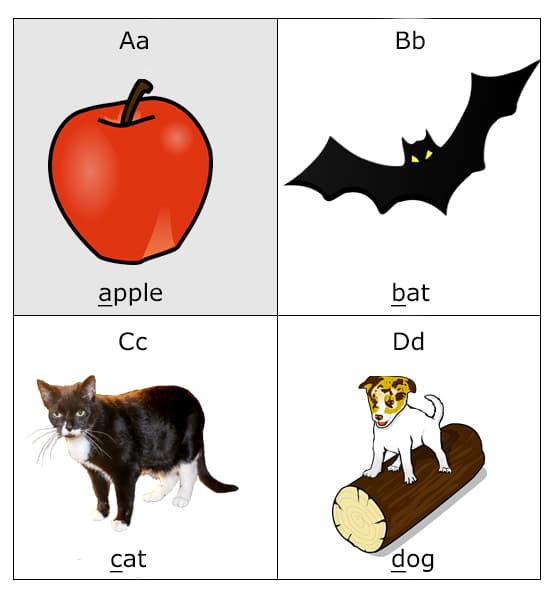

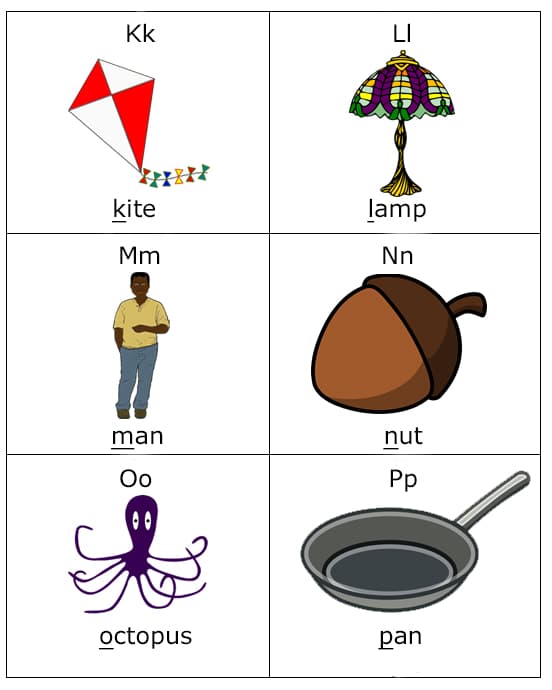
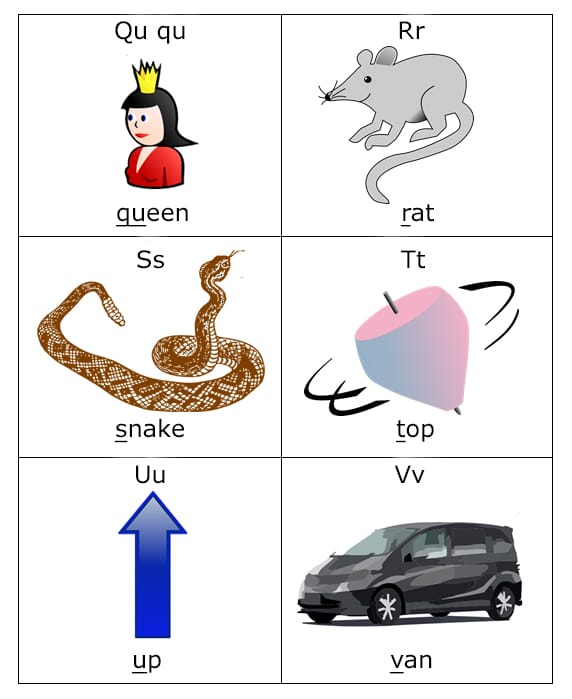
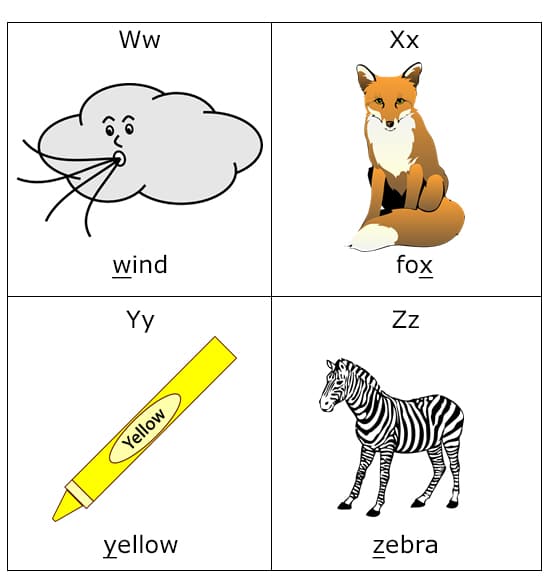
Digraphs
Step 1 also introduces five digraphs that make six different sounds. A digraph is two letters that make just one sound. These digraphs happen to be made up of consonants. At later Steps, digraphs with vowels will be introduced. These are the Step 1 digraphs and their keywords that let you know what sound the digraphs make.
Step 1 Digraphs

-ck
This is the first of four rules on how to end a word with the /k/ sound. When a closed syllable word ends with the /k/ sound, it is written as “ck.”
Possessives -‘s
The “apostrophe s” indicates that something belongs to a singular someone. It belongs to just one person, animal, etc. Tup’s leash, Jan’s idea, the fish’s pond. (Leash, idea, and pond are NOT Step 1 words. They are just examples for the idea of possession.)
Although the ‘s often makes the sound like “s” in snake, it can also make a sound like “z” in zebra. My daughter’s teacher said it was not necessary to spend too much time explaining that as kids will have learned the possessive s sound naturally as they learned to talk. Janelle knows the possessive sound for our dog’s food and our cat’s food are different. Possessive -s’ for plural owners will be discussed at a future Step.
Syllables
In Before the Squiggle Code, the skill of listening for syllables was taught.
Syllables are clumps inside of words. Each syllable has a vowel sound. If your child can’t hear the syllables in the words, have them put their hand under their chin as they say each word. Have them count the number of chin drops. For most words, each time they feel their chin drop it is a syllable. That is because each syllable has a vowel sound and vowel sounds make us open our mouths.

English words can be made up of multiple syllable types. There are six types of syllables. It is important for new readers to learn the syllable types. This way, when they start reading words with more than one syllable in Step 8, they can use their knowledge of syllables to sound out the word and identify the correct sound of the vowel.
It is helpful to instruct how to mark each syllable type. This will also help new readers decode multi-syllable words.
Here is the word “pineapple.” It has been marked to indicate the three syllable types that it includes. Do not try to figure out what all the marks mean at this time. Discussion of the marks for each syllable type will be presented when the syllable type is introduced. For now, notice the swooping mark underneath each syllable.

Syllable Type: Closed
Steps 1 through 4 have just one type of syllable. It is called a “closed syllable.” Closed syllables end in a consonant and have a single short vowel. (This is one of the reasons why kids need to know what is a consonant and what is a vowel.)
To mark a closed syllable, draw a swooping line underneath the letters of the syllable. Next, draw a breve, which looks a bit like a smiley mouth, over the short vowel. Finally, write a “c” for closed syllable underneath the swoop line.
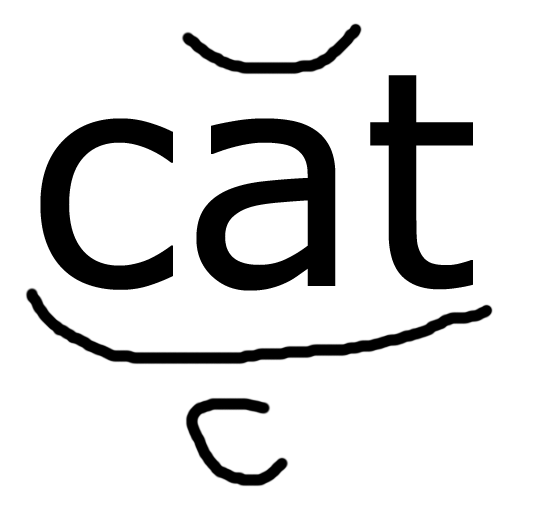
Step 2
Bonus letters (f, l, s, z after short vowel)
“all”
–s suffix
Bonus Letters (f, l, s, z after short vowel)
When any of the letters f, l, s, or z are at the end of a word and they follow a short vowel, they are doubled. It can help a new reader to know that they are doubled because f is frightened, l is lonely, and s is scared. Examples would be puff, tell, less.
There are very few 3-sound words that end with double z: buzz, fizz, fuzz, jazz, and razz. Depending on the capabilities of the learner it may not be worth instructing them in double z at this time.
Letter Buddies “all.”
The letters “all” make the sound you hear in “ball.” Examples of words with “all” are call, mall, and tall. You can remember this sound with the keyword “ball.” Because the sounds in “all” are so close together, they are tapped as a single sound.
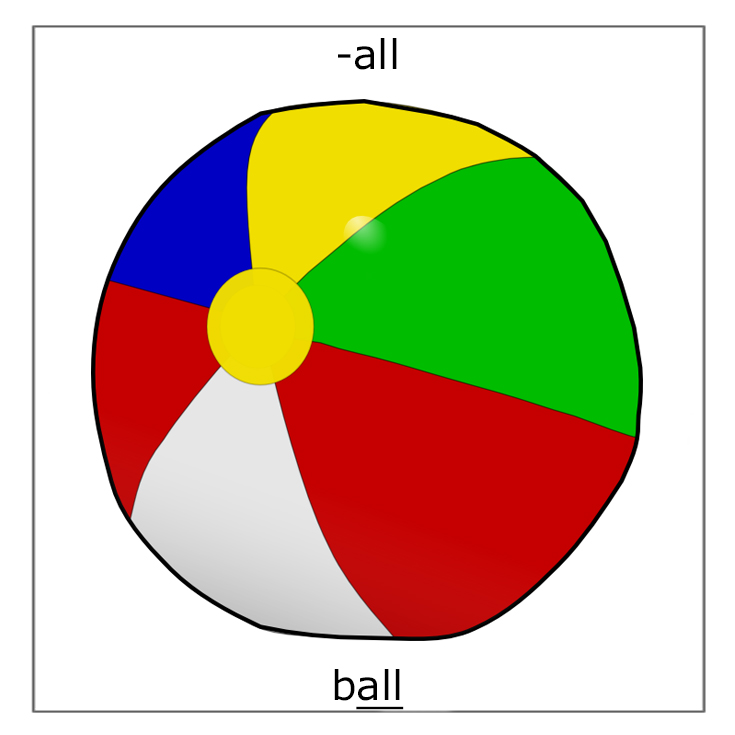
–s suffix
One way to make a noun into a plural is to add “s” to the end of the word. Although there are other ways to make nouns plurals, those rules will not be added until later steps. It may help if you tell your child to read the base word then add the s after they have sounded out the word.
Step 3
Letter Buddies: ang, ing, ong, ung, ank, ink, onk, unk
ang, ing, ong, ung, ank, ink, onk, unk
The vowels and consonants in these letter buddy combinations do not make quite the same sounds as they make individually. When they are tapped, you tap three fingers (middle finger, ring finger, pinkie) together. The sounds they make are in the following keyword tables:
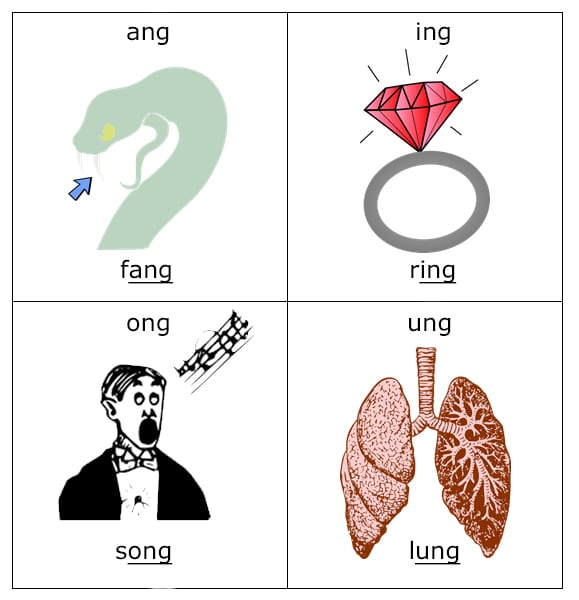
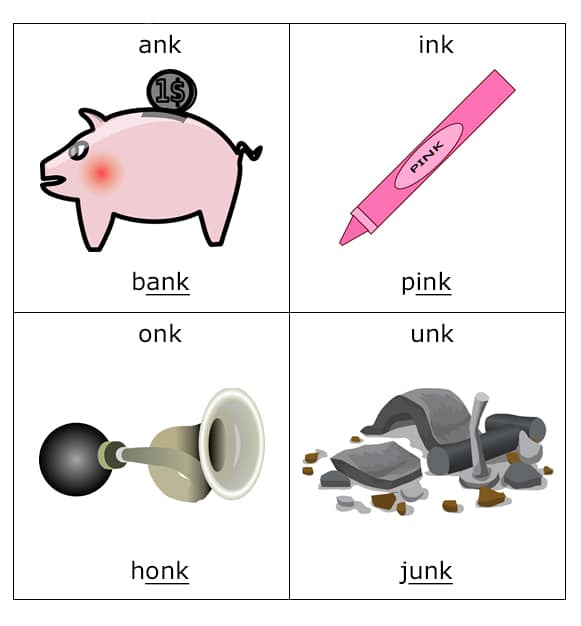
Step 4
Consonant blends to make 4 sound words
3 and 4 sound words ending in –lk, -sk
Consonant Blends
Consonant blends are two or three consonants that stand next to each other and each letter sound is heard. In this step, only consonant blends with two letters will be introduced. Unlike digraphs, in consonant blends each letter will make its distinct sound. When you tap consonant blends, you tap one finger for each sound.
3 and 4 sound words ending in –lk, -sk
This is the second rule on how to end a word in a /k/ sound. If there is a short vowel sound followed by a consonant and /k/ sound, it will be written with a k. (milk, task)
Step 5
Digraph blend –nch to make 3 and 4 sound words
Silent e, including “-ke”
Digraph Blend –nch to Make 3 and 4 Sound Words
A digraph blend is a consonant and a digraph. In this step -nch is introduced. The n and ch will each be tapped as individual sounds. Examples include inch, hunch.
Silent e, Including “-ke”
The silent e, or magic e, is used in several phonics rules. In Step 5 it is used in its most traditionally known sense. The silent e after a consonant makes the preceding single vowel say its name. This form of silent e is also known as “v-c-e” or “VCe” which stands for “vowel-consonant-e.”
“-ke”
This is the third rule for ending a word with a /k/ sound. If there is a long vowel sound before the /k/ sound, it will be written with a “k.” (cake, leak)
Syllable Type: VCe
The second syllable type instructed in the DOG ON A LOG progression is “VCe.” The “e” after the consonant is silent and the single vowel before the consonant says its name.
To mark a VCe syllable, draw a swooping line underneath the letters of the syllable. Next, draw a macron, which is a short horizontal line, over the long vowel. Cross out the silent “e.” Finally, write a “v-e” for VCe syllable underneath the swoop line.
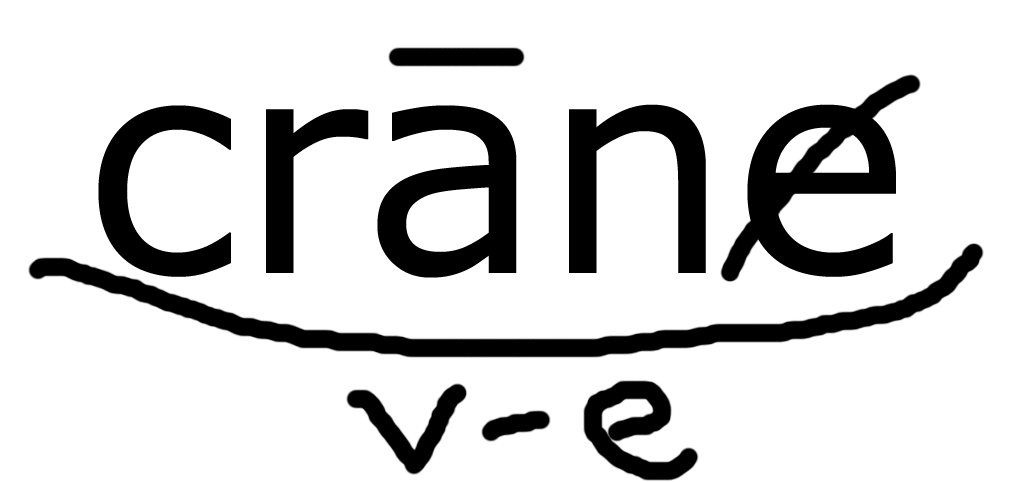
Step 6
Exception words containing: ild, old, olt, ind, ost
Exception words containing: ild, old, olt, ind, ost
Typically, closed syllables have short vowel sounds. However, there are frequently exceptions to English phonics rules. For this set of letter buddies, the vowel sound is often, but not always, long. The keywords are below. Remind your student that post and host have a long “o” sound, but cost and lost do not. We also read “wind the clock” and “the wind blew over our umbrella.” When tapping these letter buddies, tap three fingers at the same time.
Here are the keywords to help remember the sound these letter buddies make.
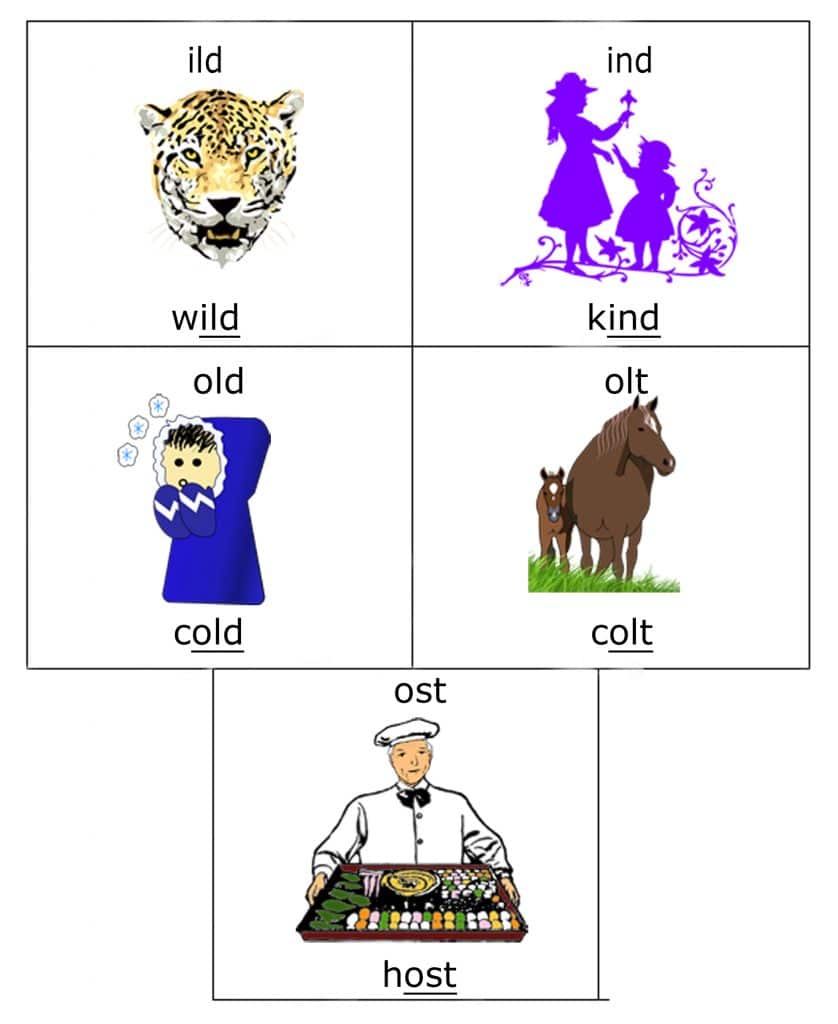
Step 7
5 sounds in a closed syllable word plus suffix -s (crunch, slumps)
3 letter blends and up to 6 sounds in a closed syllable word (script, spring)
5 Sounds in a Closed Syllable Word Plus Suffix -s
These closed syllable words include a short vowel and a consonant blend at the beginning and end of a word with or without the suffix -s. Each sound is tapped individually. Examples are twist and crests.
3 Letter Blends and up to 6 Sounds in a Closed Syllable Word
These closed syllable words include a short vowel and a consonant blend with three distinct consonant sounds. There can also be another consonant blend in the word. Each sound is tapped individually. Common three consonant blends are scr, spl, spr, and str. Examples are the words split and strong.
Step 8
Two syllable words with 2 closed syllables, not blends (sunset, chicken, unlock)
Two Syllable Words with 2 Closed Syllables, not Blends
Your child may need practice with reading, clapping, and marking two syllable words before trying to read them in a book. In Before the Squiggle Code syllables were introduced using compound words which are two single syllable words combined to make a new word. Then silly syllables were combined to make new words. You may want to start practicing/playing with words like:
backpack, bathtub, bobcat, catnip, cobweb, fishnet, gumball, hilltop, hotshot, humbug, pickup, pitfall, sunfish, sunset, tiptop, uphill, within
Then move on to words that are not made up of two individual words such as:
anvil, attic, banquet, basset, bucket, denim, habit, jonquil, kitten, linen, magnet, oxen, puppet, rabbit, radish, robin, rocket, sonic, unless, vanish, zigzag
You could download two-syllable word flashcards and play games before you start reading the books. Other syllable resources are available at www.pinterest.com or www.teacherspayteachers.com.
Here is how you mark a word with two closed syllables.

Step 9 (In Production)
Two syllable words with all previously introduced sounds including blends, exception words, and silent “e” (blacksmith, kindness, inside)
Vowel digraphs: ai, ay, ea, ee, ie, oa, oe (rain, play, beach, tree, pie, goat, toe)
Two Syllable Words with all Previously Introduced Sounds Including Blends, Exception Words, and Silent “e”
If your child is comfortable with the two syllable words from Step 8, it is time to introduce words that combine all the phonics rules they have been taught up to this point.
Here is an example of how to mark a word with two different syllable types. In this case, a closed syllable and a VCe syllable.

Vowel Digraphs: ai, ay, ea, ee, ie, oa, oe
Digraphs are two letters that combine to make one sound. There are several different vowel digraphs that make an assortment of sounds. In this step, the vowel digraphs all have the first letter say its name (long vowel sound) and the second vowel is silent. Some people like to say, “When two vowels go walking, the first one does the talking.” Although that is true in these vowel teams, it is not always true so could be confusing when additional vowel digraphs are taught. You could say, “In this step of words, when two vowels go walking, the first one does the talking. We will learn other sounds that they make later.”
Here is the keyword with the vowel digraphs used in Step 9.
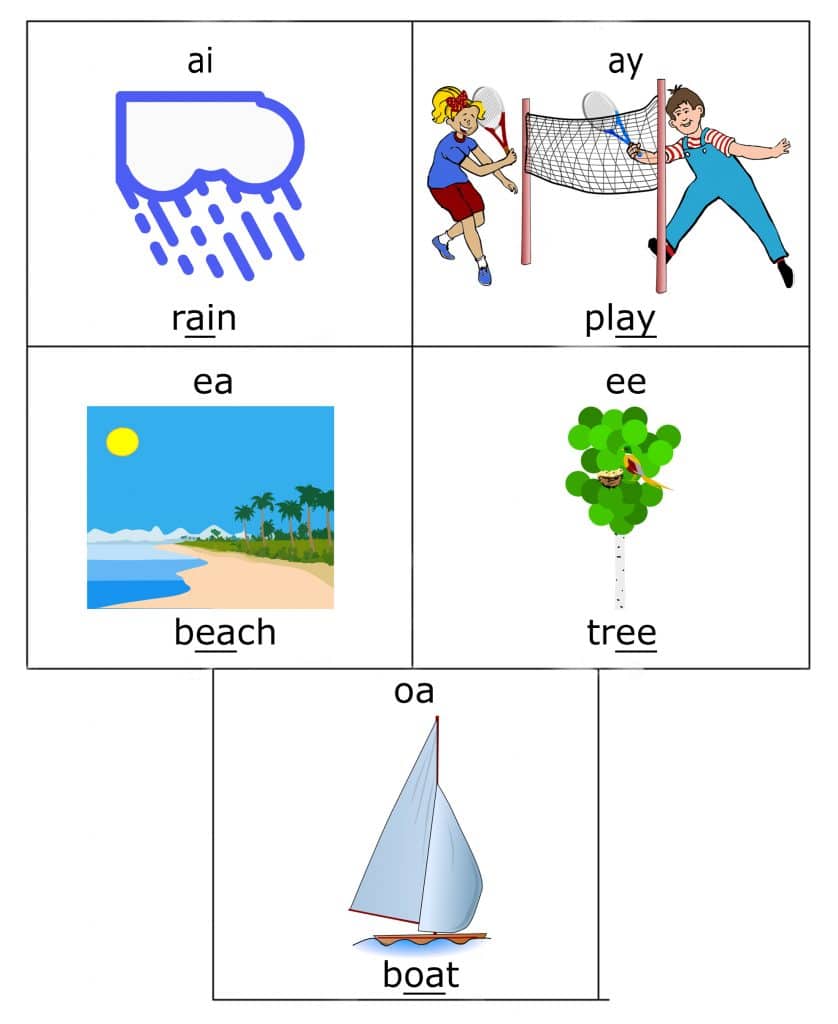
As I previously mentioned, as I write this, Janelle and I are playing the card game “Get Tup” where we combined the Step 5 VCe words and the Step 9 long vowel sound digraph words. We ask for cards that have words with the same long vowel sound. This was challenging for her at first, but one time while we were playing, she said, “This isn’t so hard.” We’re still playing it, but it is getting easier.
Syllable Type: Double Vowel
The third syllable type instructed in the DOG ON A LOG progression is “double vowel.” There are two types of double vowel teams: vowel digraphs and vowel diphthongs. Vowel diphthongs will be introduced in a future step.
To mark a double vowel syllable, draw a swooping line underneath the letters of the syllable. Next, circle the vowel team. Finally, write a “d” for double vowel syllable underneath the swoop line.
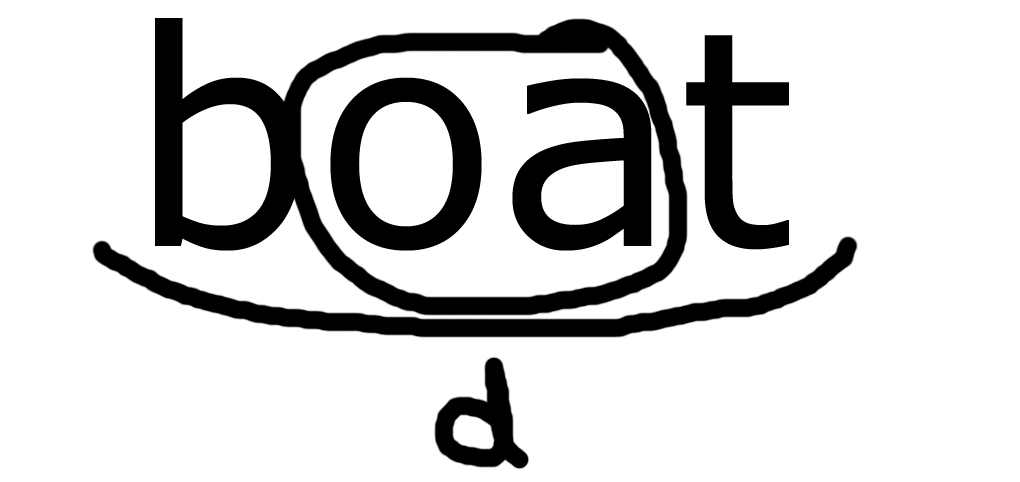
Step 10 (Upcoming)
Open syllables including y as the long vowel sound “i” (be, so, dry)
2 syllable words containing:
Open syllables (beside, recall, myself)
Previously learned sight words (outside, somewhere)
vowel teams ai, ea, ee, ie, oa, oe (raindrop, sixteen)
Open Syllables Including y as the Long Vowel Sound “i” (be, so, dry)
An open syllable is a syllable that ends with a single vowel that makes a long vowel sound. Numerous open syllable words have been previously introduced as sight words so your child may be comfortable reading them. Words previously introduced are:
a, be, go, he, my, she, do, I, me, we, no, so, hi
Other single syllable, open syllable words include:
bro, by, cry, fly, spry, try, why
As you can see, most of the single syllable open syllable words that have not been introduced all have y as a vowel. Tell your child that y is sometimes a vowel. In single syllable words where the y is at the end of the word, it will make the long “i” sound.
Syllable Type: Open
The fourth syllable type instructed in the DOG ON A LOG progression is the “open syllable.” An open syllable is a syllable that ends with a single vowel that makes a long vowel sound.
To mark an open syllable, draw a swooping line underneath the letters of the syllable. Next, draw a macron, which is a short horizontal line, over the long vowel. Finally, write an “o” for open syllable underneath the swoop line.
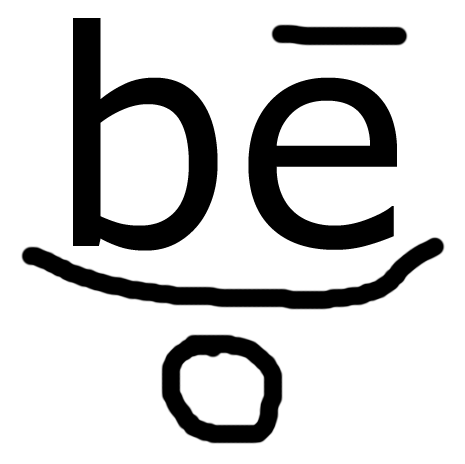
2 syllable words containing:
- Open Syllables (beside, recall, myself)
- Previously Learned Sight Words (outside, somewhere)
- Vowel Digraphs (Teams): ai, ea, ee, ie, oa, oe (raindrop, sixteen)
Two syllable words in Step 10 now add previously introduced sight words and the vowel digraphs that were taught in Step 9. These could be combined with any previously introduced sounds or they could be combined with themselves. For example, two sight words could be combined as in “outcome.”
Since sight words frequently do not follow typical syllable patterns, I will not include any examples for marking two-syllable words that contain a sight word.
Because so many open syllable words have been used as sight words in previous steps and because the majority of words containing open syllables are multisyllabic, two syllable words with open syllables are also used in Step 10. This would include open syllables that have not been used before such as in the words “remind” and “open.” Open syllables can also be the last syllable of a word such as “bingo” and “maybe.” Words with two open syllables include “silo” and “veto.”
Here is an example of how to mark a two-syllable word with an open syllable.

Here is an example of how to mark a two-syllable word with a closed syllable and a double syllable.

More Rules are coming
This book is available to read or download as a free printable pdf bookfold. It is also available as an e-book from many online booksellers. Although I always request it be sold for free, each merchant has the right to set their own price. As more steps of rules/books are added to the DOG ON A LOG series, I will update this booklet. When it is finished, I will make it available in paperback format.
FOREWORD moved to the back. I guess this is now the BACKWORD
DOG ON A LOG Books were born in a grocery store parking lot. I’d spent several weeks being despondent I could not find a series of decodable (sound out) chapter books for my daughter to read. Then, after exceeding our weekly grocery budget, I was beside myself about buying some expensive decodable books I had just discovered. At that moment I had an epiphany: “I’m a writer. I can write the books she needs!!!” Since I knew other families needed them as much as I did, I decided, almost on the spot, to publish them as DOG ON A LOG Books.
Since then I have learned so much about the learning to read process for both individuals with dyslexia as well as typical learners. I initially saw DOG ON A LOG Books as being a series of books that experts in dyslexia could use or that families who had tutors that were teaching their kids could use. However, now that I’m hearing from families that want to know how to use DOG ON A LOG Books themselves, I am creating this booklet.
Much of the information in this booklet will be useful even if you are not using DOG ON A LOG Books. If you are using a different program with a different phonics progression, take what I say about daily activities, tapping, and everything else, and use it or adapt it to your child’s needs as you see best with the program you are using.
In this booklet I will focus on using DOG ON A LOG Books to teach reading. Since my child has dyslexia, much of my focus will be on teaching children with dyslexia. However, the learning to read progression is pretty much the same for anyone learning to read. Individuals with dyslexia mainly need more repetition and finesse. If you have a struggling reader, with or without dyslexia, you may wish to read my book Teaching a Struggling Reader: One Mom’s Experience with Dyslexia. It is available to read or download as a free printable pdf bookfold. It’s a quick read with over 100 hyperlinks for those who want more information. It is the book I wish I’d had when I first suspected my daughter has dyslexia. It is also available as an e-book from many online booksellers. Although I always request it be sold for free, each merchant has the right to set their own price. You can also buy it as a paperback book.
I will include a few excerpts from Teaching a Struggling Reader in this booklet because they are specific to using DOG ON A LOG Books. One of the topics I discuss in that book is that 65% of US Fourth-graders are not proficient readers because their teachers are not taught how to teach reading. For children with dyslexia, the reality is a huge percentage of teachers don’t even know what dyslexia is much less how to teach someone who has dyslexia. I won’t repeat that information here so please know it is available in Teaching a Struggling Reader.
After the third edition of that book came out, Emily Hanford of APM published this article, At a Loss for Words: How a flawed idea is teaching millions of kids to be poor readers. The article addresses why the methods schools use for teaching reading don’t work. Additionally, laws are slowly being passed requiring schools to evaluate for dyslexia. However, bureaucracies are slow and teaching children with dyslexia is intensive and therefore expensive. It may take a while before most schools make appropriate changes for teaching kids to read. In the meantime, I hope the information in this book gives you an outline on how to help your child learn to read.
I was really lucky that my daughter Janelle’s first teacher made it a goal to teach me how to teach Janelle. Since we homeschool, she saw me as the primary teacher. She was right that I needed to know what to do. For a year I watched how she guided my daughter. During those sessions, I asked questions and came up with fresh ideas that were appropriate to Janelle’s learning needs. We could only afford to pay for two tutoring sessions a week. Then we went home and I was the teacher. (I am grateful we could afford twice a week sessions as I know so many families cannot afford any tutoring.)
Although I know the ideal way to teach my daughter, the reality is I’m just not able to do it every day. (Maybe not even most days.) We are a real family with real kids that don’t always want to cooperate with their parents’ great ideas. We are a real family with too many stray dogs that now live with us that seem to always need cactus thorns removed or who need to be stopped from barking at the cat in the garage. We are a real homeschooling family who has days where we just have too many other homeschool or life things going on during the day. Then it’s late and we’re all tired and we didn’t do all the school stuff we should have done that day. It helps that we do school stuff year-round but, like many, if not most, good parents, I usually have a sense of guilt that I can’t do it all. So, in this booklet I tell you what I think would be the best plan for using DOG ON A LOG Books, but know that I probably couldn’t keep up with it every single day.
Excerpts from
Teaching a Struggling Reader: One Mom’s Experience with Dyslexia
Irregular or Sight Words
Tapping
Letter Reversals
Motivators
Irregular or Sight Words
Learning words that do not follow rules (or are introduced before the rule of a critical word is taught) takes a different approach. There are many ways to teach sight words. This is the method my daughter’s first teacher used and it was quite successful:
- The word is written with marker in 2-inch tall letters on strips of cut up paper grocery bags. (I also have pre-made strips on my printables pages.)
- With two fingers, she underlines the word while saying the word.
- With two fingers she traces each letter while saying the letter’s name.
- She underlines the word again while saying it.
- She pauses then starts the whole process over.
- She repeats this until she feels she can write it.
- She writes it on paper or a dry erase board then verifies its spelling.
- She writes it again and verifies her spelling.
- She writes each word a minimum of 5 times.
- Then the word is added to our daily flashcard stack.
Sometimes this is all that is needed. Other words require us to do this multiple times. I have been told some kids will have to trace a complicated word at least 100 times to learn it. As I said, this learning style requires lots of repetition.


Tapping (Sounding Out)
For sounding out words, we “tap.” Start with the index finger for the first sound and touch it to your thumb. The middle finger is for the second sound, so you tap your middle finger to your thumb, and so on. It’s more complicated for more complicated words, but that gives you an idea. It makes it multi-sensory as compared to just saying the sounds. Although I’ve been reading for several decades, I find this approach makes a lot of sense to my brain. When my daughter struggles with a word, I remind her to tap. It’s so much easier when she uses this strategy.

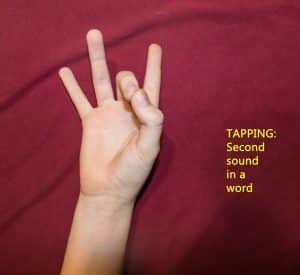
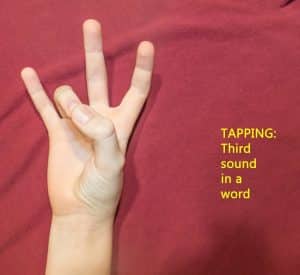
Letter Reversals
Since lowercase “b” “d” “p” “g” and “q” can look alike to many people, you can help your child remember those letters this way:
“b” and “d” Make Your Bed
The letters “b” and “d” are easily confused. When they are in a word, she can make her left-hand look like a “b” and her right-hand look like a “d.” The letter bellies touch each other and she has made a “bed.” She can then see which hand the print letter looks like to determine whether it is a “b” or a “d.”
Some people do not want others to see them “making their bed.” This technique can be done with hands resting in the lap. No one will notice what is happening, but the reader or speller will get the reminder they need.
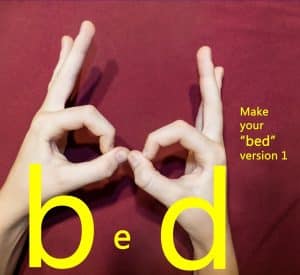
OR
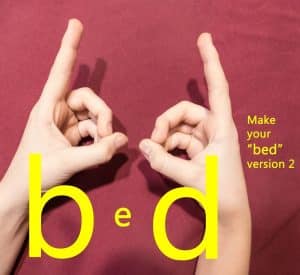
“p” and “g” See a Pig
If your child cannot remember if it’s “p” or “g”, they can make their hands into a pig. Tell them to make thumbs down and touch their fingers together. Their fingers will be the letter bellies. The letter bellies will touch each other and they will see a “pig.” They can then see which hand the print letter looks like to determine whether it is a “p” or a “g.”
Some people do not want others to see them “making a pig.” This technique can be done with hands resting in the lap. No one will notice what is happening, but the reader or speller will get the reminder they need.

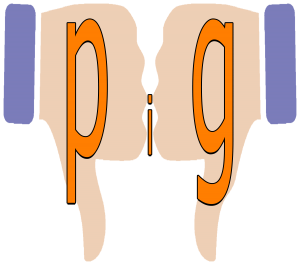
“q” Is a Chicken Letter
If your child cannot remember if it’s “q” or some other letter, tell them to look and see if its buddy “u” is there. There may be times when “p” or “g” have a “u” with it, but if there is no “u” they will know it is not a “q.”
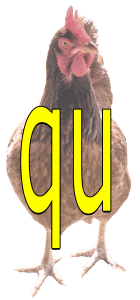
Rewards as a Motivator
From the beginning, my daughter’s specialist gave her $1 in play money for every effort she made. It was not for correct answers; it was for effort. This was really critical. Every time my daughter tried, she got $1. Often in an hour session she would get $100.
In time, my daughter got paid a lump sum (usually $100) at the end of the session. I would stock rewards she could buy with her play money. Initially, I kept small items in a treasure box that she could look through at the end of each session. They would cost about $100 each. It was stuff she would like from the dollar store or a thrift store. When time passed and she asked for more expensive items, I told her she would have to save up. A $5 throw blanket cost her $500. A gigantic stuffed husky cost her $4,000 and took months for her to earn.
Leaving a session without any reward was not realistic. I made sure she would be able to get a reward by keeping a small bag of yogurt covered pretzels in her treasure box. They were $5 each and she could buy 2 of them per session. She’d usually choose to spend $10 on pretzels and save the rest for the big item she wanted.
That was in the sessions with her specialist. We tried various versions of this at home. Ultimately, my secret weapon was a piece of gum. My daughter would read for a piece of gum. One time I found out my husband (who did not know my reward system) bought her an entire pack of gum. I panicked that I would not have a reward for her. Fortunately, she loved gum enough that she rapidly ate it and remained enthusiastic to earn the gum I bought. (My husband did not buy her more gum after he found out about my system.)
I sometimes used this method for the kids in my co-op class. Once, I didn’t have any play money with me and a 9-year-old boy was being really resistant. I tore up pieces of napkin and told him that for every ten pieces of napkin he earned, he would get to play a Chicken Card (from the Get Tup to the Hall boardgame.) He loves the Chicken Cards and so became very engaged in the activity we were doing. It’s all about finding the reward that is important to each child.
(It’s more than a year later. Eventually my daughter decided she did not need the rewards any more. Her teacher had said that would happen as it does with most kids. I still find sometimes it helps her to have a reward for when she’s done with all her homework. I’m that way too. If I’m doing an unfun task, I like to set small rewards for myself. Like most people, when I’m at work, I like to get paid.)
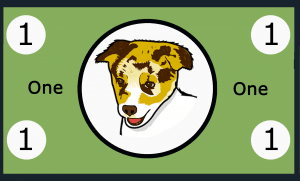
Tup money is available to download from this page.
Reading Together as a Motivator
Another way to try and make reading fun is to do it together without any stress. At night my husband and daughter read together. Usually they are snuggled together on the couch or in bed. They read a book that is easier than those I read with her during the day. He reads one paragraph then she reads the next. If she can’t read a word, he tells it to her. He never makes her try and sound out (decode) a word. He just tells her and they move on. We hope that this positive time where she doesn’t have to work hard will help her associate reading with something more than hard work.
Play as a Motivator
I am trying to find a way to help her learn to love to read and to be intrinsically motivated. Because reading can be so hard, that feels like a big challenge. How many kids wake up and say, “I want to do something that makes my brain smoke and I want to do the same thing I’ve done every day for the last several months.” Since she’s still young, play is an important part of her life and playing with me is an especially wonderful thing to do. After she reads to me each day, we use toys to re-create what she just read to me. So far, she loves this, but I’m starting to see the newness of it wear off. Still, I’m hoping that associating reading with playing with Mom will make her feel warm and fuzzy about reading. Plus, the more we read in a single session, the more we have to re-enact with the toys. I’m also hoping our play will help solidify her comprehension of what she reads. So far, I’m seeing she has a good understanding of what she just read, even if her reading isn’t 100% fluent. I don’t know if playing this way will make a difference in the long run, but it’s one more way to add fun to the basics. This journey is about modifying the path to the needs of the student and this is our current modification.
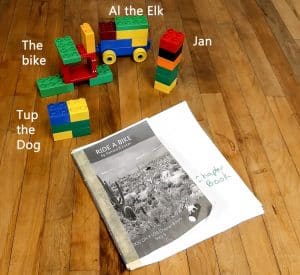
She reads my books as stapled together computer printouts. Then we play.
Why Decodable Books?
If you wanted your child to learn to play piano, you would not hand them the sheet music for Etudes-tableaux, Op. 39: No. 1 in C Minor, Allegro agitato and tell them, “Here, play this.” You would start by going to preschool music groups where they would clap to the beat of simple songs and twirl with scarves to happy music. As they got older, you’d show them how to place their fingers on a piano’s keyboard. You would give them simple songs with only two or three notes. Then you’d build up to Chopsticks and Twinkle, Twinkle, Little Star. With time and practice you would have them play more and more complicated songs. From the very beginning you would immerse them in music by playing music in the car or while cleaning the house. You might have picnics at Music Under the Stars by the local pops orchestra or city symphony. You might even start singing together while walking down the frozen foods aisle at the grocery store.
There are some kids who could sit at a piano and play Fur Elise without much difficulty, but those children are the exception. Most kids just don’t learn that way.
Reading is the same. Some kids will do well if you simply read to them. It seems as if by osmosis they learn to read. However, most kids are not like that. They learn best when they start by playing games to learn about rhymes, letter sounds, syllables, and words. Then they are taught a few letters and sounds and helped to sound out using these combinations. As they learn the connections between the speech sounds and print, they are ready for books with words that have those letters and those sounds.
Decodable books are books that follow the rules. They can be sounded out by anyone who has been taught the sounds and letters that are used in that book. Systematic, sequential decodable books are a series of books that add a few more sound-letter correspondences in each subsequent book, or group of books, of that series.
Of course, kids need to be immersed in books from the time they are infants. They need parents who read language-rich books with interesting characters that take them on amazing adventures. Children need library story time and books filled with pictures where they can imagine the stories even before they can read the words. Many kids love audio books that have paper books where they can follow along with the words as they listen to the book.
In time, children will no longer need to read decodable books. They will have gained the skills to read books that do not attempt to control spelling patterns. They will simply read what is in front of them and have the skills to master new words. And that is the goal of decodable books: to help new readers and children with dyslexia master printed words and become fluent readers. They are a tool for learning to read and will eventually be a fond memory.

DOG ON A LOG Books
Finally, a delightful book series that helps kids learn phonics rules step by step. Fun and engaging books designed for anyone learning to read with phonics, especially learners with dyslexia. Start anywhere in the series, according to your child’s reading level.
The DOG ON A LOG Books series are for phonics readers and folks with dyslexia. They are decodable books which means a learner who has been taught the phonics rules and the limited sight words in that book can sound them out and read them. They are systematic because one Step of books follows another. The words used reflect the inclusion of 1 to 3 new phonics rules in each Step. Each Step of books builds on the skills practiced in the prior Steps. There are five books at each Step.
The chapter books are written in chapter format with one picture in most chapters. They are longer, have more detail, and usually offer more complexity than the Let’s GO! Books. They’re great for practicing known and newly introduced phonics rules. They’re also just fun reading.
DOG ON A LOG Let’s GO! Books are shorter versions of DOG ON A LOG Chapter Books. Let’s GO! books tell the same stories with about 8 pictures and only a few sentences per page. They’re perfect as an introduction to the new phonics rules or simply for fun reading for younger kids.
Kids who read DOG ON A LOG Books tend to be over-the-moon-proud that they can finally read a book without so much frustration. This builds confidence in new and struggling readers. Their parents are excited that, along with reading sight words, their kids can decode every word on every page. With each progressing step, the readers gain more confidence as the vocabulary, grammar, and stories become more complex and they see their skills and abilities growing with the books.

